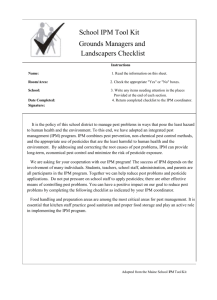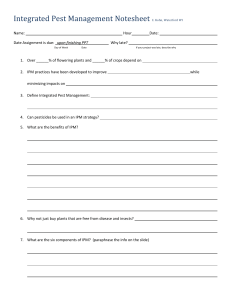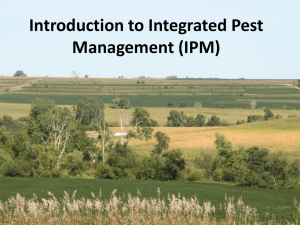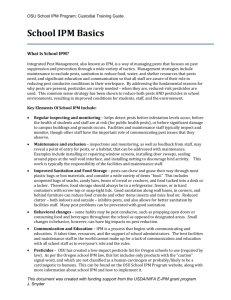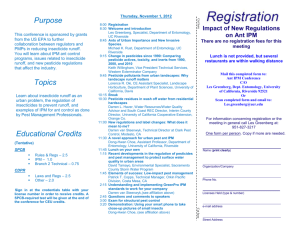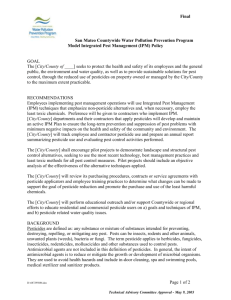Food Services Staff Checklist
advertisement
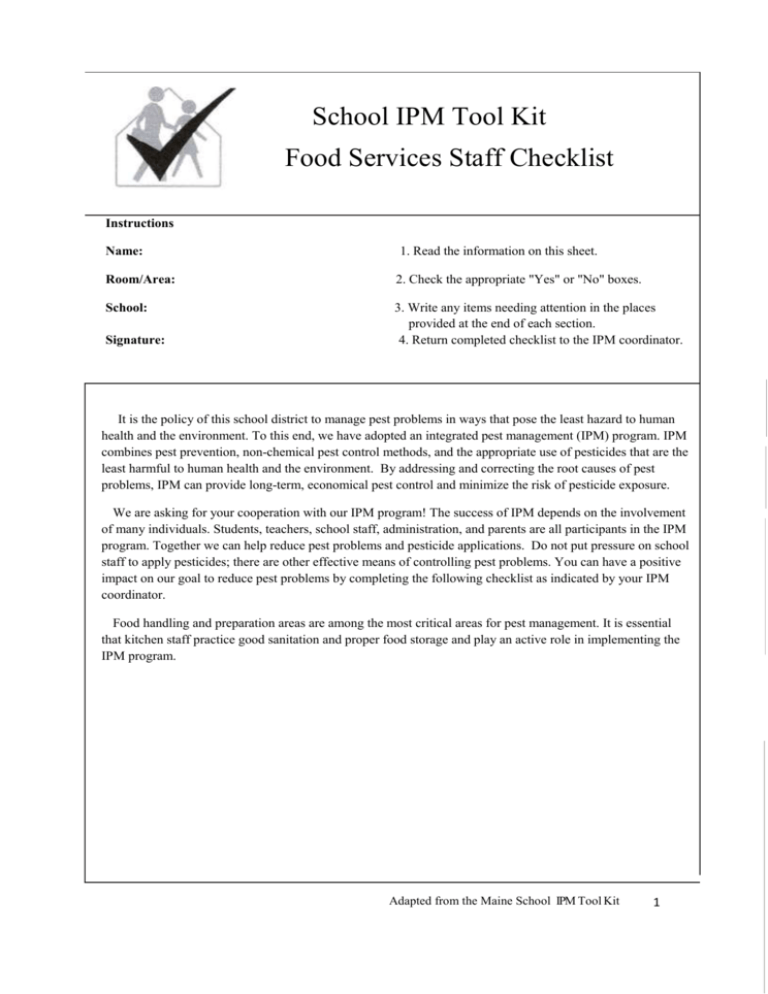
School IPM Tool Kit Food Services Staff Checklist Instructions Name: 1. Read the information on this sheet. Room/Area: 2. Check the appropriate "Yes" or "No" boxes. School: 3. Write any items needing attention in the places provided at the end of each section. 4. Return completed checklist to the IPM coordinator. Signature: It is the policy of this school district to manage pest problems in ways that pose the least hazard to human health and the environment. To this end, we have adopted an integrated pest management (IPM) program. IPM combines pest prevention, non-chemical pest control methods, and the appropriate use of pesticides that are the least harmful to human health and the environment. By addressing and correcting the root causes of pest problems, IPM can provide long-term, economical pest control and minimize the risk of pesticide exposure. We are asking for your cooperation with our IPM program! The success of IPM depends on the involvement of many individuals. Students, teachers, school staff, administration, and parents are all participants in the IPM program. Together we can help reduce pest problems and pesticide applications. Do not put pressure on school staff to apply pesticides; there are other effective means of controlling pest problems. You can have a positive impact on our goal to reduce pest problems by completing the following checklist as indicated by your IPM coordinator. Food handling and preparation areas are among the most critical areas for pest management. It is essential that kitchen staff practice good sanitation and proper food storage and play an active role in implementing the IPM program. Adapted from the Maine School IPM Tool Kit 1 Food Services Staff Checklist Inspections and Pest Monitoring Yes No 0 0 Water is not left standing in steam tables or sinks when not in use and never overnight. 0 0 Openings around electrical conduits, pipe chases, and ducts are sealed or covered with escutcheon plates. 0 0 Floor drains are covered with screens. 0 0 Drain traps are kept full of water. 0 0 Sewer lines are in good repair. 0 0 Out-of-date charts or paper notices are removed from walls monthly. Action needed: Completed (Date/Initials) Adapted from the Maine School IPM Tool Kit 2 Food Services Staff Checklist Cleaning Yes No 0 0 All kitchen areas are cleaned thoroughly before the end of each day in use. 0 0 Pits below dumb waiters are checked and cleaned frequently. 0 0 Portable items such as food carts and tray racks are cleaned frequently and kept free of food debris. Steam cleaning is preferable. 0 0 All used dishes and utensils are cleaned by the end of the day. 0 0 All surfaces are cleaned and dry by the end of the day. 0 0 Surfaces in food preparation and serving areas are regularly cleaned of any grease deposits. 0 0 Vending machines are maintained in clean condition inside and out. 0 0 Wiping cloths, aprons, and other linens are disposable or laundered daily. 0 0 Mops and mop buckets are properly dried and stored after each use. 0 0 Drain covers are removed and drains are cleaned weekly with a long-handled brush and cleaning solution. 0 0 Overflow water trays in refrigeration units are cleaned and emptied regularly. 0 0 Areas around and under appliances and furnishings that are rarely moved are thoroughly cleaned at least monthly to remove accumulated grease, dust, etc. Action needed: Completed (Date/Initials) Adapted from the Maine School IPM Tool Kit 3 Waste Management Yes No 0 0 Dumpsters have rain covers or lids in good condition and are kept closed to keep rodents out and garbage in. 0 0 Dumpsters are never allowed to overflow. The lid can always be fully closed. 0 0 Dumpsters are located as far away as practical from building entrances and windows. 0 0 Garbage that is not put in dumpsters is placed in lined trashcans. If outdoors, cans have tight fitting lids and are kept closed when not in use. 0 0 Garbage cans are cleaned periodically with hot water and detergent. 0 0 Food waste is stored in sealed plastic bags and placed, not tossed, into dumpster so bags do not break open. 0 0 Food that has come in direct contact with pests (such as ants, mice, cockroaches, meal worms, or other stored product pests) is considered contaminated and is discarded promptly. 0 0 Packing and shipping trash (bags, boxes, pallets) is promptly and properly recycled. 0 0 Recyclable containers are washed with soapy water before storage or stored refrigerated or in pest-proof containers and regularly moved offsite. 0 0 Waste with liquid food residues (e.g., milk cartons, juice boxes) are drained of excess liquid before discarding. 0 0 Weather stripping and door sweeps are present and in good condition on exterior doors. Action needed: Completed (Date/Initials) Adapted from the Maine School IPM Tool Kit 4 Storage Yes No 0 0 Stored products are rotated on a "first in, first out'' basis. Storing unnecessary quantities of items is avoided. 0 0 Food storage areas are inspected twice monthly for evidence of pests. 0 0 Any evidence of pests (droppings, insects, webbing, gnawed holes in packaging or walls) are promptly recorded in the logbook and reported to the IPM coordinator for appropriate action. 0 0 Food products are stored in refrigerators or in pest-proof containers. 0 0 Torn or broken food packaging is repaired as soon as possible or, if damaged, the food is repacked in new containers. 0 0 Foodstuffs and dry goods are stored at least 12" off the floor in tightly sealed, pest-proof containers such as plastic storage boxes. 0 0 If possible, shelving units are kept away from walls to allow for inspection 0 0 Open metal shelving is used for storage. Wooden shelving is avoided. 0 0 Food and non-food items are stored separately to facilitate inspection and pest prevention. 0 0 Food is not left uncovered or exposed overnight. 0 0 Inspection aisles (at least 6" x 6") are maintained around bulk stored products. 0 0 Shelf paper is not used. Action Needed: Completed (Date/Initials) Adapted from the Maine School IPM Tool Kit 5 Other Control Measures Yes No 0 0 Unscreened doors and windows leading outdoors from food service areas (especially to dumpsters) are never left propped open. 0 0 Broken door sweeps, screens, and door closers are promptly reported and repaired. 0 0 Cracks and crevices in walls and floors and around permanent fixtures are promptly reported and caulked. 0 0 Purchases of new kitchen appliances and fixtures are of pest-resistant design (i.e., open design, few or no hiding places for insects, freestanding and on casters or wheels for easy thorough cleaning). Action needed: Completed (Date/Initials) Adapted from the Maine School IPM Tool Kit 6


